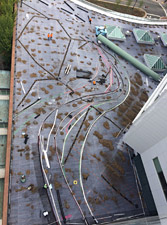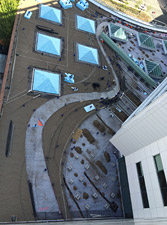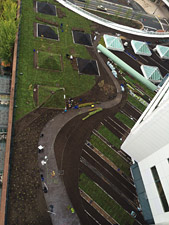Hospital’s new green roof offers more than a green space

When patients at the University of Virginia Hospital gaze out of their windows, they are now greeted by what appears to be a flowing river winding through a landscape of picturesque mountains and idyllic farmland. The new green roof above the hospital’s main lobby — which was completed in October — includes a large amount of vegetation and plantings, providing many benefits over a traditional roof. In addition to its visual appeal, the green roof reduces the hospital’s environmental impact and over time it will reduce operating costs.
The design of the vegetation was rooted in both the healing properties of nature and the terrain of the Charlottesville area. The project’s engineer, Roofmeadow, notes studies published in Scientific American that suggest that hospital gardens and greenery can have a positive impact on patients, promoting relaxation and boosting healing. In addition to including vegetation with calming colors and patterns that create visual interest for patients, the Charlottesville landscape provided inspiration for the design team.



“The concept was to replicate the local geography,” according to Senior Project Manager Will Moore. Sedum-covered pyramids mimic the area’s mountains and rolling hills while ornamental grasses separated by stone curbing create a pattern similar to the region’s agricultural fields. Charlottesville’s own Rivanna River was the inspiration behind the roof’s winding “river,” which is filled with blue glass aggregate.
“The grasses along the ‘river’ will grow a couple of feet like trees along a river bank,” explains Moore.
Construction Administration Manager Nate Brown notes that all of the plants used on the roof are native species of Virginia and they were selected based on their particular location on the roof — for example, the vegetation planted alongside the edge of the building (which will be in the shade the majority of the day) does not require much sunlight.
The benefits of a green roof extend beyond its visual attraction, providing numerous positive environmental impacts, such as reducing energy consumption. Vegetated roofs keep buildings warmer in the winter, through improved thermal properties, and cooler in the summer, by reducing what is known as the “heat island effect.” This effect results in rising temperatures in areas with a high number of urban surfaces, such as pavement and traditional roofs, that heat to greater temperatures than natural landscapes.
The green roof also reduces storm-water runoff through the absorption of rainwater into the soil. Plus, the condensate from the hospital air handlers will be captured and used in the roof irrigation system to further reduce runoff.
The University encourages the incorporation of green roofs into its structures for all of these benefits. There are currently close to 10 other vegetated roofs across Grounds with plans for additional projects in the future.
Jane DeGeorge
Communications Generalist
Human Resources & Training
UVA Facilities Management
(434)982-5846
jad2tm@virginia.edu
Photos by Jennifer Watson and Nathaniel Brown Jr., UVA Facilities Management